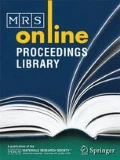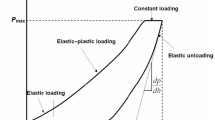Abstract
In this paper a method is described to observe shrinkage microcracks on ‘wet’ specimen cross-sections of cement-based materials with Environmental Scanning Electron Microscopy (ESEM). A sample cooling device which can be used in the ESEM chamber was built to control the relative humidity above a microscope sample. The accuracy of measuring relative humidity is determined to be 5% at a sample temperature of 3°C. A microscope sample preparation method and a pump-down sequence of the ESEM-chamber, both without any drying of the sample, are described. Preliminary results show that in the studied mortar the visibility of shrinkage microcracks on a ‘wet’ specimen cross-section is low due to closure of microcracks by swelling of the cement paste.
Similar content being viewed by others
References
C.L. Hwang and J.F. Young. Drying shrinkage of Portland cement pastes. I. Microcracking during drying. Cem. Con. Res. 14, 585 (1984).
A.D. Jensen and S. Chatterji. State of the art report on microcracking and lifetime of concrete - part 1. Mat. Struct. 29, 3 (1996).
E. Ringot, J.P. Ollivier, and J.C. Maso. Characterisation of initial state of concrete with regard to microcracking. Cem. Con. Res. 17, 411 (1987).
A. Bascoul, J.P. Ollivier, and A. Turatsinze. Discussion of the paper ‘Fracture zone presence and behaviour in mortar specimens’ by N. Krstulovic-Opara. ACI Mat. J. 91 (5), 531 (1994).
H.C. Gran. Fluorescent liquid replacement technique. A means of crack detection and water:binder ratio determination in high strength concretes. Cem. Con. Res. 25 (2), 1063 (1995).
P.J.R. Uwins, Environmental scanning electron microscopy. Mat. Forum. 18, 51 (1994).
K.O. Kjellsen and H.M. Jennings. Observations of microcracking in cement paste upon drying and rewetting by environmental scanning electron microscopy. Advn. Cem. Bas. Mat. 3, 14 (1996).
J. Bisschop and J.G.M. van Mier. Quantification of shrinkage microcracking in young mortar with fluorescence light microscopy and ESEM. Proc. 7th euroseminar on Microscopy Applied to Building Materials, June 1999, Delft, The Netherlands.
V. Penttala. Freezing-induced strains and pressures in wet porous materials and especially in concrete mortars. Adv. Cem. Bas. Mat. 7, 8 (1998).
R.E. Cameron and A.M. Donald. Minimizing sample evaporation in the environmental scanning electron microscope. J. Micr. 173 (3), 227 (1994).
B.J. Griffin. Hydrated specimen stability in the electroscan ESEM: specimen surface temperature variations and the limitations of specimen cooling. Proc. 50th annual meeting EMSA. San Francisco, 1306 (1992).
H.W. Reinhardt. Beton als constructiemateriaal - eigenschappen en duurzaamheid. Delft University Press. 152 (1985).
Acknowledgments
The assistance of Mr. A. S. Elgersma with the construction of the ESEM cooling device is gratefully acknowledged. Financial support was obtained from Delft Interfaculty Research Program ‘Micromechanics for macroscopic lifetime prediction’ (DIOC-10).
Author information
Authors and Affiliations
Corresponding author
Rights and permissions
About this article
Cite this article
Bisschop, J., Van Mier, J.G.M. Environmental Scanning Electron Microscopy as Tool to Study Shrinkage Microcracks in Cement-Based Materials. MRS Online Proceedings Library 589, 141 (1999). https://doi.org/10.1557/PROC-589-141
Published:
DOI: https://doi.org/10.1557/PROC-589-141




